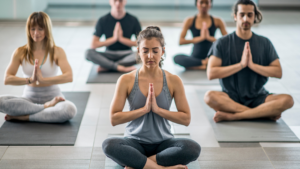
Your hip flexors play a crucial role in mobility, stability, and posture. These muscles, located at the front of your hips, are responsible for lifting your knees, bending your hips, and stabilizing your body. If you spend a lot of time sitting, your hip flexors may become tight and weak, leading to discomfort, back pain, and reduced mobility.
Incorporating hip flexor exercises into your routine can help improve flexibility, enhance athletic performance, and reduce the risk of injury. Below are eight easy and effective exercises to strengthen your hip flexors.
1. Standing Hip Flexor March
This simple exercise is excellent for engaging the hip flexors and improving balance.
- How to do it: Stand tall with your feet hip-width apart. Slowly lift your right knee toward your chest while keeping your core engaged. Lower your leg back down and repeat on the other side. Perform 10-15 reps on each leg.
- Benefits: Strengthens your hip flexors and improves balance.
2. Seated Leg Lifts
Seated leg lifts are great for targeting the hip flexors while also engaging the lower abs.
- How to do it: Sit on a chair or the floor with your legs extended. Engage your core and lift one leg a few inches off the ground, keeping it straight. Hold for a second, then lower it slowly. Repeat 10-12 times for each leg.
- Benefits: Improves hip flexor strength and core stability.
3. Hip Bridges
Although hip bridges primarily target the glutes, they also work the hip flexors, particularly when you squeeze your hips at the top.
- How to do it: Lie on your back with your knees bent and feet flat on the floor. Press your heels into the ground and lift your hips toward the ceiling, squeezing your glutes and engaging your core. Hold for a few seconds, then lower down. Repeat 12-15 times.
- Benefits: Strengthens the hip flexors, glutes, and lower back.
4. Lunges
Lunges are a functional movement that strengthens the entire lower body, including the hip flexors.
- How to do it: Stand tall with your feet hip-width apart. Take a step forward with one leg and lower your body until both knees form 90-degree angles. Push back up to the starting position and repeat with the other leg. Aim for 10-12 reps per leg.
- Benefits: Builds strength in the hip flexors, quads, and glutes.
5. High Knees
This cardio exercise is also an excellent way to engage and strengthen your hip flexors.
- How to do it: Stand with your feet hip-width apart. Start jogging in place, driving your knees up as high as possible, engaging your core as you move. Perform this for 30-60 seconds.
- Benefits: Boosts hip flexor strength, improves cardiovascular health, and enhances coordination.
6. Mountain Climbers
Mountain climbers not only work your hip flexors but also provide a full-body workout.
- How to do it: Start in a plank position with your hands directly under your shoulders. Drive one knee toward your chest, then quickly switch legs, as if you’re running in place. Perform for 30-45 seconds, keeping your core tight.
- Benefits: Strengthens the hip flexors, core, and upper body while improving endurance.
7. Lying Leg Raises
Lying leg raises effectively isolate and target the hip flexors while also working the lower abs.
- How to do it: Lie flat on your back with your legs extended. Place your hands under your hips for support. Slowly lift both legs off the ground until they’re at a 90-degree angle, then lower them back down without touching the floor. Repeat 10-15 times.
- Benefits: Strengthens the hip flexors, core, and lower abs.
8. Frog Stretch
Although not a strengthening exercise, this stretch is essential for maintaining flexibility in your hip flexors and preventing tightness.
- How to do it: Begin on all fours, then widen your knees while keeping your feet together. Lower your hips back toward your heels while pressing your forearms into the floor. Hold this stretch for 30-60 seconds.
- Benefits: Improves flexibility in the hip flexors, groin, and inner thighs.
Conclusion
Strong hip flexors are vital for overall lower body strength, stability, and flexibility. Incorporating these exercises into your regular workout routine can help you enhance mobility, prevent injuries, and improve athletic performance. Remember to start slowly and progress at your own pace to avoid straining the muscles. With consistency, you’ll notice significant improvements in both strength and flexibility in no time!
By taking care of your hip flexors, you’re investing in better posture, smoother movement, and greater overall body health.





